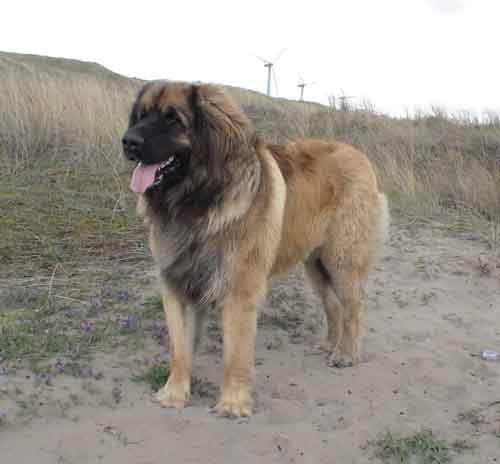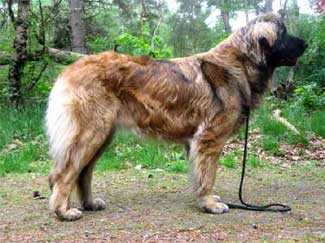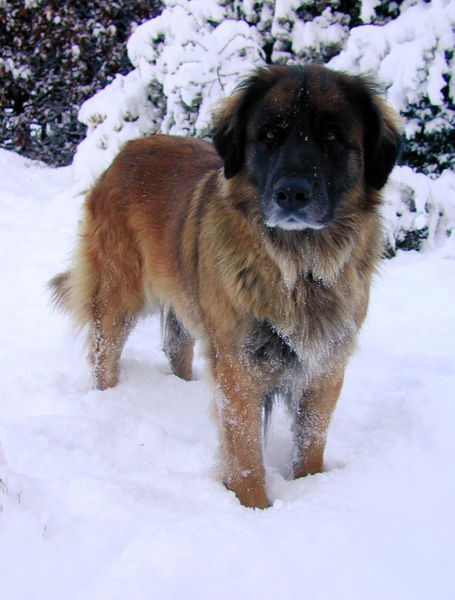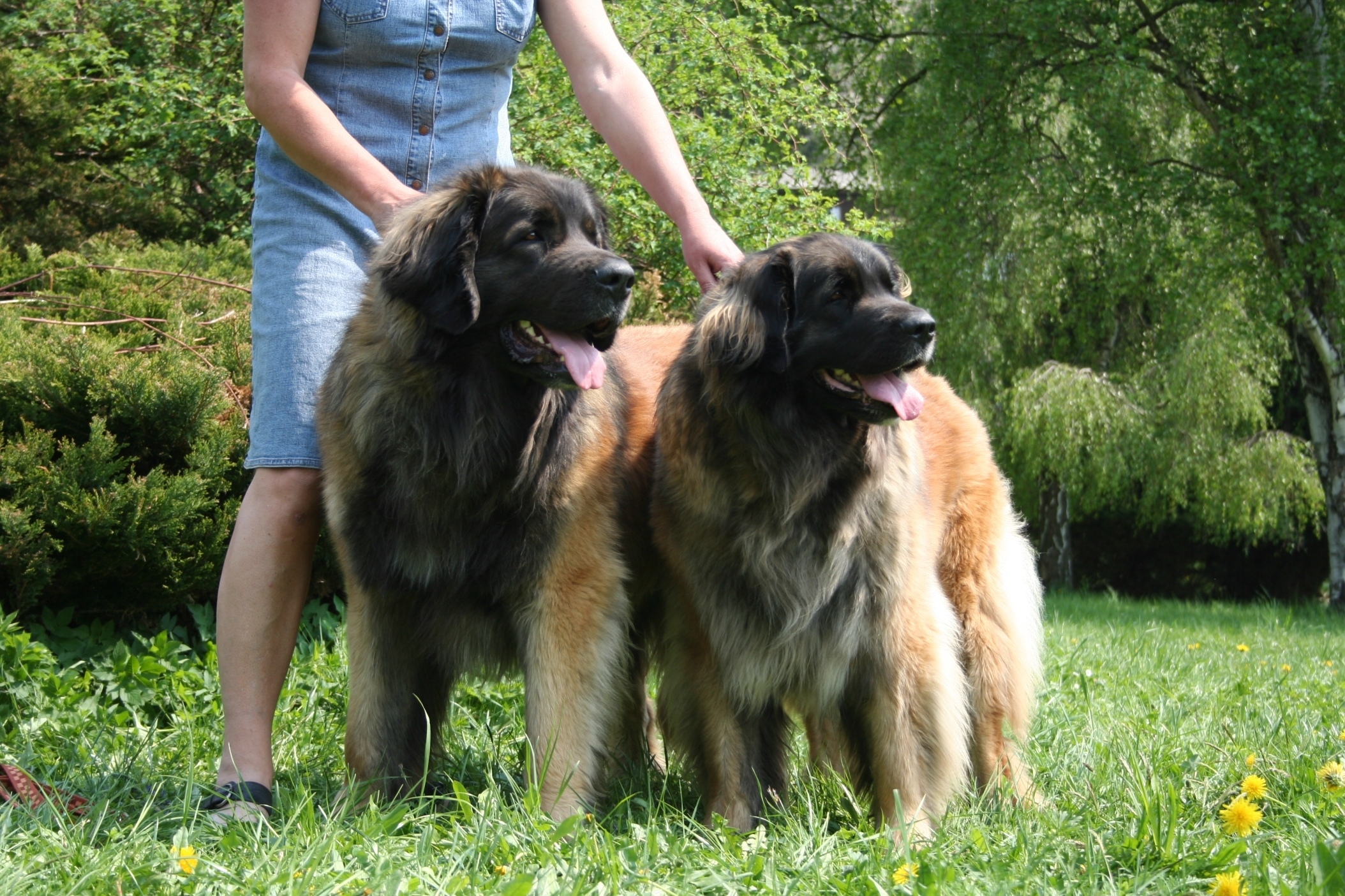
The Leonberger is a very large breed, proud and majestic in appearance, with a characteristic black mask. The females will be slightly smaller. The skull is domed. The medium-sized, pendant ears flank kind and gentle brown eyes. The face will have a black mask, which should not extend above the eyebrows in show dogs, and the nose and lips are black. The teeth meet in a scissors bite. Unlike most large breeds, the Leonberger has a dry mouth, and therefore doesn't drool. The powerful neck will have no dewlap. The coat is long and rough-looking, with colors that vary from tawny to reddish-brown. Black-tipped hair on the outer coat is acceptable in show dogs, as is a small white star on the chest, or white on the tips of the paws. Males have a larger mane than the females, and can take up to four years to develop. Both the front and rear legs are feathered, and the rear dewclaws should be removed. The tail is set low, and long, reaching at least to the hocks, and bushy. The feet of the Leonberger have black pads, and webbing between the toes which helps in swimming. The coat is water-proof.
add infoThe Leonberger, like most giant dogs, is usually calm and confident, kind and gentle, and considered to have a sweet expression. They are intelligent and friendly, and are very patient, even with children. Rather than showing aggression, the Leonberger normally walks away from misbehaving children. Obedience training is important, but the trainer must be patient - harsh training methods do not work with this breed. The Leonberger is considered agile for its size. They get along with other dogs, but must be well-socialized, as early as possible.
Leonbergers get unusually attached to their family and do not enjoy being left alone. Although large, they are very adaptable and therefore they fit in easily to an active family life.
The Leonberger is known to sometimes become arrogant when it realizes its size in comparison to other dogs. It's sometimes said it will get a 'why should I bother' attitude but will always respond to commands if properly trained. The Leonberger is agile, fast and energetic for a breed of its size and enjoys tasks. The Leonberger is protective of its family and its size alone will often detour an intruders. Often this breed is more protective of females and children than males.
The Leonberger is known to be especially strong willed until it reaches the age of 12-16 months. It may occasionally challeng its owner for the dominate role. The Leonberger should be trained with positive, consistent training methods to achieve a desired temperament in adulthood. This breed is family oriented and desires the attention and affection from owners.
add infoThe Leonberger is prone to hip dysplasia, as well as other skeletal diseases/disorders. Eyelid defects and bone disease have also been reported.. Well cared for, the Leonberger lives about 9 years.
The Leonberger is prone to bloat. Most live to 11 years old at the very oldest.
add infoThe Leonberger was established in 1846 by German breeder Heinrich Essing, by cross-breeding a Newfoundland, St. Bernard, and the Great Pyrenees. Legend has it that he was attempting to create a breed that would resemble the Leonberg town crest. Many royal families owned the breed. It was used for guarding livestock and tracking purposes, as well as water rescue. After the end of World War I, not a lot of the breed were left...and although the breed was re-established it was almost destroyed again during the privations of World War II. German breeders re-established it again, however, and the official standard was set in 1949. The first Leonberger was brought to the United States in 1971 - currently there are almost one thousand dogs registered.
During the 1920's a man named Mr. Wolf imported his Leonbergers to the USA from Germany. In 1927, he bred the first litter in the United States under the Kennel name Berkeley-Kimmel. Mr. Wolf lived and died in Newark, New Jersey. There are currently 2,800 to 3,000 Leonbergers in Britain, excluding the Republic of Ireland. Leonbergers were almost exterminated during the World Wars, with only 5 left in the UK after WW1 and just 8 after WW2. Although not recognized by the American Kennel Club, they are recognized in the UK and Europe.
As of January 1, 2010, the Leonberger is recognized by the American Kennel Club.
add infoThe Leonberger sheds heavily during season, and should be brushed and combed daily, but other than that time, weekly brushing is fine. Always check behind the ears, the tail, and the feathering on the legs for mats. The ears must be kept clean to avoid ear infections, and teeth should also be brushed on a regular basis. Bathe only when necessary.
add infoThe Leonberger is most comfortable in cool climates, and can live inside or outside, but prefers to be with its humans. They can be kept in apartments, as they are relatively lazy, but will do best in a large yard. They are keen swimmers, and once old enough, can be trained to pull carts or sleds.
The Leonberger is known to grow very quickly but does not fully mature until at least two years of age and sometimes later for males. An average Leonberger will weight 100 pounds at one year. Its bones will still be soft at this age and stressful training and work should be avoided. Carting, agility, weight pulling is normally started at 18 months old.
add info| Puppies For Sale | Find a Breeder | Rescue a Dog |
|---|---|---|
| Be the First to take out an Ad! |

Berlin, DE
Die Hobbyzucht im „Butzemannhaus“ ist geprägt von Liebe und Respekt gegenüber den Tieren. Ich sehe meine Tiere nicht... |
Be the First to take out an Ad! |
 |
I've found the 2 breeds to have very similar personalities, in that the variation within the breeds is more than the variation between the breeds. If I *had* to make a distinction (so the answer isn't completely boring), I'd say that I've seen more Leonbergers that are athletic and high energy, and I've seen more Leonbergers that have an aggressive streak in them. |
 |
My leonberger was around 30kg at 5 months. I wouldn't worry too much about what the scales say, it's better to go by how he looks and behaves. If you can feel his ribs with gentle pressure he's about right. It's also difficult to consult charts with leonbergers as these dogs are easy to just feed and feed and many people's leos weigh enormous amounts. Its not good for them to put on too much weight as it affects their bone development. |
 |
We had our drained by his vet. Vets don't seem to like to do this because they feel it is not necessary since it does not effect the health of the dog. To be honest I just didn't like it being there so we had it drained. |
 |
Leonbergers are much more protective of the females and children in a family than the male in charge. The male in charge is considered by a Leonberger to be the Alpha of his pack thus should not need his protection as much. Their huge size along with their deep bark is usually enough to deter almost anyone with some common sense. |
 |








